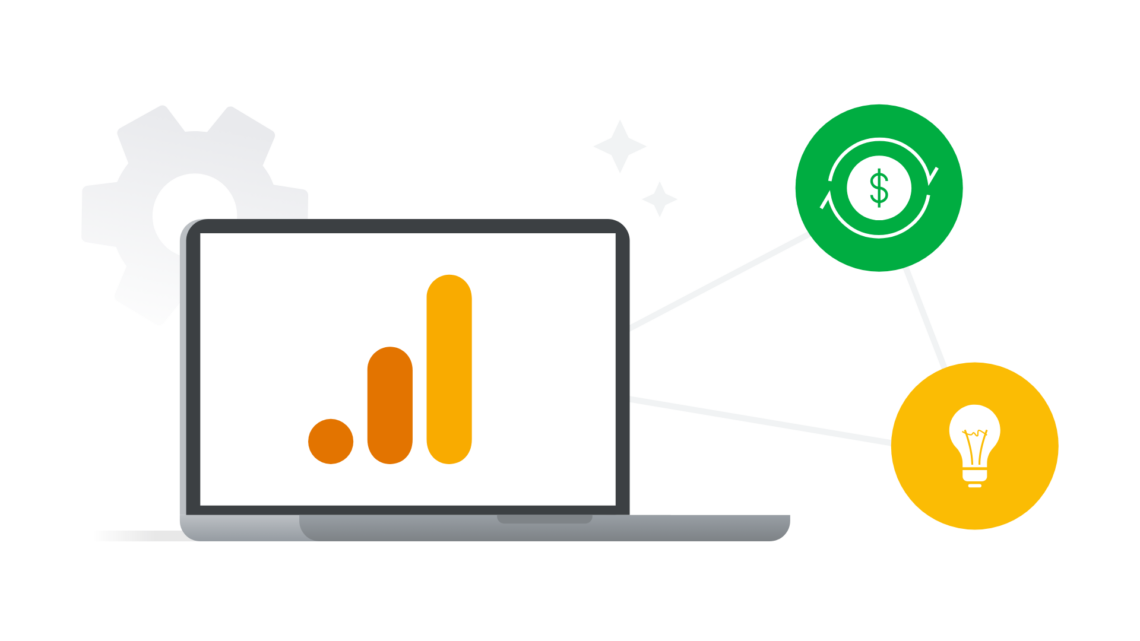Google Analytics is a powerful web analytics tool that provides valuable insights into your website’s performance and visitor behavior. As a beginner, understanding how to leverage Google Analytics effectively can seem daunting at first. However, with the right guidance, you can unlock a wealth of data to inform your digital strategy and drive business growth.
In this comprehensive guide, we’ll walk through the essentials of Google Analytics, from setting up your account to analyzing key metrics and utilizing advanced features. By the end, you’ll have a solid foundation to start making data-driven decisions for your website or online business.
What is Google Analytics?

Google Analytics is a free web analytics service offered by Google that tracks and reports website traffic. It allows you to measure your advertising ROI as well as track your Flash, video, and social networking sites and applications.
Why is Google Analytics important for businesses?
In today’s digital landscape, having a strong online presence is crucial for businesses of all sizes. Google Analytics provides the insights needed to understand your audience, optimize your website, and make informed marketing decisions. Here are some key reasons why Google Analytics is essential:
- Understand your audience: Gain insights into who your visitors are, where they come from, and how they interact with your site.
- Improve website performance: Identify which pages are performing well and which ones need improvement.
- Track marketing efforts: Measure the success of your marketing campaigns across various channels.
- Optimize conversion rates: Analyze user behavior to improve your conversion funnel and increase sales or leads.
- Make data-driven decisions: Base your business strategies on real data rather than assumptions.
Benefits of using Google Analytics
- Cost-effective: Google Analytics is free for most businesses, offering powerful insights without a hefty price tag.
- User-friendly interface: While comprehensive, the platform is designed to be accessible for users of all skill levels.
- Real-time data: Get up-to-the-minute information on your website’s performance.
- Customizable reports: Create tailored reports that focus on the metrics most important to your business.
- Integration capabilities: Easily integrate with other Google services and third-party tools.
By leveraging these benefits, you can gain a competitive edge and make more informed decisions about your online presence.
Getting Started with Google Analytics
Now that we understand the importance of Google Analytics, let’s dive into how to set it up for your website.
Creating a Google Analytics account
- Go to google.com/analytics
- Click on “Start for free” or “Sign in to Analytics” if you already have a Google account
- Follow the prompts to set up your account:
- Choose between a website or mobile app
- Provide your website or app name
- Enter your website’s URL
- Select an industry category
- Choose your time zone
Setting up tracking code on your website
Once you’ve created your account, you’ll need to add the Google Analytics tracking code to your website. This code allows Google to collect data from your site.
- In your Google Analytics account, go to Admin > Property > Tracking Info > Tracking Code
- You’ll see a snippet of JavaScript code starting with
<!-- Global site tag (gtag.js) -> - Copy this code and paste it into the
<head>section of every page on your website
Tip: If you’re using a content management system like WordPress, you can use a plugin to add the tracking code automatically.
Understanding the Google Analytics interface
The Google Analytics interface may seem overwhelming at first, but it’s organized logically to help you navigate through the data. Here’s a brief overview of the main sections:
- Home: Provides a snapshot of key metrics and recent reports
- Customization: Create custom reports, dashboards, and segments
- Reports: Access detailed reports on various aspects of your website’s performance
- Admin: Manage account settings, properties, and views
Take some time to explore these sections and familiarize yourself with the layout. As you become more comfortable with the interface, you’ll be able to navigate to the information you need quickly and efficiently.
Key Metrics to Track
Now that your Google Analytics account is set up, let’s explore some of the essential metrics you should be tracking to gauge your website’s performance.
Sessions and users
- Sessions: A session is a group of user interactions with your website that take place within a given time frame.
- Users: This metric represents the number of unique individuals who have visited your site.
Why it matters: Tracking sessions and users helps you understand your overall traffic volume and how many people are actually visiting your site.
Bounce rate
Bounce rate is the percentage of single-page sessions in which there was no interaction with the page.
Why it matters: A high bounce rate could indicate that your landing pages aren’t relevant to your visitors or that your site has usability issues.
Average session duration
This metric shows how long, on average, visitors stay on your site during a session.
Why it matters: Longer session durations generally indicate that users are finding your content engaging and valuable.
Pages per session
Pages per session represents the average number of pages viewed during a single session.
Why it matters: This metric can help you understand how deeply users are engaging with your site and navigating through your content.
Acquisition channels
Acquisition channels show you how visitors are finding your website. The main channels include:
- Organic Search
- Direct
- Referral
- Social
- Paid Search
Why it matters: Understanding where your traffic is coming from helps you focus your marketing efforts on the most effective channels.
To view these metrics:
- Log into your Google Analytics account
- Navigate to the “Audience Overview” report (Audience > Overview)
- Adjust the date range as needed to view data for your desired time period
By regularly monitoring these key metrics, you’ll gain a solid understanding of your website’s performance and be better equipped to make data-driven decisions to improve user engagement and achieve your business goals.
Advanced Features and Functionalities
As you become more comfortable with the basics of Google Analytics, it’s time to explore some of its more advanced features. These tools will help you gain deeper insights into your website’s performance and user behavior.
Setting up goals and conversions
Goals in Google Analytics allow you to track specific actions that you want users to take on your website, such as making a purchase or signing up for a newsletter.
To set up a goal:
- Go to Admin > View > Goals
- Click “+ New Goal”
- Choose a goal template or create a custom goal
- Define the goal details (e.g., destination page, duration, pages/session, or event)
- Assign a value to the goal (optional)
Pro tip: Set up multiple goals to track different types of conversions on your site.
Creating custom reports
Custom reports allow you to combine specific dimensions and metrics that are most relevant to your business.
To create a custom report:
- Go to Customization > Custom Reports
- Click “+ New Custom Report”
- Name your report and choose a type (Explorer, Flat Table, or Map Overlay)
- Select the metrics and dimensions you want to include
- Set up filters if needed
- Save your report
Utilizing segmentation
Segments allow you to analyze subsets of your data based on specific criteria.
To create a segment:
- Click on “+ Add Segment” at the top of any report
- Choose from pre-defined segments or create a new one
- Define your segment criteria (e.g., demographics, behavior, or technology)
- Apply the segment to your report
Integrating with Google Ads and other platforms
Google Analytics can be integrated with various other platforms to provide a more comprehensive view of your digital marketing efforts.
To link Google Ads:
- Go to Admin > Property Settings
- Under “Google Ads Linking,” click on “Google Ads Linking”
- Select the Google Ads account you want to link
- Choose the views where you want to see the Google Ads data
- Turn on linking
Tip: Consider integrating Google Analytics with other tools like Google Search Console, Google Data Studio, or your CRM system for even more powerful insights.
By leveraging these advanced features, you’ll be able to gain more detailed insights into your website’s performance and make more informed decisions about your digital strategy.
In-Depth Analysis and Insights
Now that we’ve covered the basics and some advanced features, let’s dive deeper into how you can use Google Analytics for comprehensive analysis and actionable insights.
Website performance analysis
Analyzing your website’s performance goes beyond just looking at traffic numbers. Here are some key areas to focus on:
- Site speed: Go to Behavior > Site Speed to see how quickly your pages load. Slow-loading pages can negatively impact user experience and SEO.
- Mobile performance: Use the Mobile Overview report (Audience > Mobile > Overview) to see how your site performs on mobile devices.
- Landing page analysis: Check Behavior > Site Content > Landing Pages to see which pages users enter your site through and their performance.
Action item: Identify your slowest-loading pages and work on optimizing them for better performance.
User behavior analysis
Understanding how users interact with your site is crucial for improving user experience and conversions.
- Behavior flow: Go to Behavior > Behavior Flow to visualize the path users take through your site.
- Event tracking: Set up event tracking to monitor specific interactions like button clicks or video plays.
- Site search: If your site has a search function, analyze what users are searching for under Behavior > Site Search.
Pro tip: Use the User Explorer report (Audience > User Explorer) to see individual user journeys and identify patterns in behavior.
Conversion tracking and optimization
Improving your conversion rate is often more cost-effective than increasing traffic. Here’s how to dig deeper into your conversions:
- Conversion paths: Use the Multi-Channel Funnels reports (Conversions > Multi-Channel Funnels) to see how different channels work together to drive conversions.
- Goal flow: Analyze the Goal Flow report (Conversions > Goals > Goal Flow) to see where users drop off in your conversion funnel.
- Ecommerce data: If you have an online store, set up enhanced ecommerce tracking to get detailed insights into your sales funnel.
Action item: Identify the top conversion paths and optimize your marketing efforts to focus on these effective channels.
Content engagement analysis
Understanding which content resonates with your audience can help you create more of what works.
- Top pages: Check Behavior > Site Content > All Pages to see your most viewed pages.
- Content drilldown: Use the Content Drilldown report (Behavior > Site Content > Content Drilldown) to analyze performance by content sections.
- Exit pages: Analyze where users are leaving your site (Behavior > Site Content > Exit Pages) and consider ways to keep them engaged.
Tip: Use the Page Value metric to see which pages contribute most to your goal conversions.
By conducting these in-depth analyses, you’ll gain a comprehensive understanding of your website’s performance, user behavior, and areas for improvement. Use these insights to make data-driven decisions that will enhance your online presence and drive business growth.
Mastering Google Analytics
As you become more proficient with Google Analytics, you’ll want to explore some of its more advanced capabilities to extract even deeper insights from your data.
Utilizing advanced features like custom dimensions and metrics
Custom dimensions and metrics allow you to track data that’s specific to your business needs.
- Custom dimensions: These are additional attributes you can add to your data. For example, you could create a custom dimension for “Author” to track which content creators are driving the most engagement.
- Custom metrics: These are quantitative measurements unique to your business. For instance, you could create a custom metric for “Video Plays” if this is important for your content strategy.
To set up custom dimensions and metrics:
- Go to Admin > Property > Custom Definitions
- Click on “Custom Dimensions” or “Custom Metrics”
- Click “+ New Custom Dimension/Metric”
- Name your dimension/metric and choose its scope (hit, session, user, or product)
Pro tip: Use custom dimensions and metrics in conjunction with your goals to track more specific conversion data.
Leveraging Google Analytics Intelligence for automated insights
Google Analytics Intelligence uses machine learning to automatically uncover useful insights from your data.
To access Intelligence:
- Click on the “Discover” tab in the left-hand menu
- Explore automated insights or ask questions in natural language
Example: You could ask, “What was my best performing channel last month?” and get an instant, data-backed answer.
Integrating with BigQuery for advanced data analysis
For businesses with large amounts of data or complex analysis needs, integrating Google Analytics with BigQuery can be a game-changer.
Benefits of using BigQuery:
- Analyze raw, unsampled data
- Combine Analytics data with other data sources
- Perform complex queries and data modeling
To set up BigQuery integration:
- Ensure you have a Google Cloud Platform account
- In Google Analytics, go to Admin > Property > Product Linking > BigQuery Linking
- Follow the prompts to link your BigQuery project
Note: This feature is available for Google Analytics 360 customers.
Creating data visualizations and dashboards
Visualizing your data can make it easier to spot trends and communicate insights to stakeholders.
- Google Data Studio: This free tool allows you to create interactive dashboards and reports using your Google Analytics data.
- Custom dashboards in Analytics: Create dashboards within Google Analytics by going to Customization > Dashboards > Create.
Tip: Start with a few key metrics in your dashboard and add more as you identify what’s most important for your business.
By mastering these advanced features, you’ll be able to extract more value from your Google Analytics data and make even more informed decisions about your digital strategy.
Unlocking the Full Potential of Data
Now that you’ve mastered the advanced features of Google Analytics, it’s time to focus on how to use this wealth of data to drive real business results.
Making data-driven decisions for your business
Data-driven decision making is about using the insights you’ve gained from Google Analytics to inform your business strategies.
- Identify trends: Look for patterns in your data over time. Are certain pages consistently performing well? Is there a particular time of day when conversions are highest?
- Test hypotheses: Use your data to form hypotheses about user behavior, then test these ideas using features like Content Experiments.
- Allocate resources: Use your insights to decide where to focus your time and budget. For example, if you see that a particular marketing channel is driving high-quality traffic, you might choose to invest more in that area.
Action item: Set up a regular schedule (weekly or monthly) to review your key metrics and discuss potential actions with your team.
Optimizing marketing strategies based on insights
Your Google Analytics data can directly inform and improve your marketing efforts.
- Channel optimization: Use the Acquisition reports to understand which channels are driving the most valuable traffic. Adjust your marketing mix accordingly.
- Content strategy: Analyze your top-performing content and use these insights to guide your content creation efforts.
- Audience targeting: Use demographic and interest reports to refine your audience targeting in advertising campaigns.
- Conversion rate optimization: Identify pages with high exit rates or low conversion rates and prioritize these for improvement.
Pro tip: Use the Multi-Channel Funnels reports to understand the full customer journey and give proper credit to all touchpoints in your marketing funnel.
Continuously monitoring and improving website performance
Optimization is an ongoing process. Regular monitoring and iterative improvements are key to long-term success.
- Set up custom alerts: Create alerts for significant changes in key metrics so you can respond quickly to issues or opportunities.
- Conduct regular audits: Periodically review your Analytics setup to ensure you’re tracking everything correctly and not missing any important data.
- Stay updated: Google Analytics frequently updates its features. Stay informed about new capabilities that could benefit your analysis.
- Benchmark performance: Use the Benchmarking reports to see how your site performs compared to others in your industry.
Action item: Create a performance dashboard that you update and share with stakeholders on a regular basis.
By consistently applying these strategies, you’ll be able to extract maximum value from your Google Analytics data and drive continuous improvement in your online performance.
Frequently Asked Questions (FAQ)
As you delve deeper into Google Analytics, you may encounter some common questions. Here are answers to some frequently asked questions to help you on your journey.
How long does it take for data to appear in Google Analytics?
Typically, data begins to appear in your Google Analytics reports within 24-48 hours after you’ve properly installed the tracking code. However, real-time data is available almost immediately.
Tip: Use the Real-Time reports to verify that your tracking code is working correctly.
Can Google Analytics track mobile app data?
Yes, Google Analytics can track mobile app data, but you’ll need to use Firebase, Google’s mobile app analytics solution, which integrates with Google Analytics.
Note: Setting up app tracking requires additional steps compared to website tracking.
How can I ensure data privacy and compliance?
To ensure data privacy and compliance:
- Review and update your privacy policy to disclose your use of Google Analytics
- Enable IP anonymization to comply with GDPR and other privacy regulations
- Set up data retention controls in your Google Analytics account
- Use the User-ID feature cautiously and in compliance with Google’s policies
Important: Always consult with a legal professional to ensure full compliance with applicable data protection laws.
What are the limitations of Google Analytics?
While powerful, Google Analytics does have some limitations:
- Sampling: For accounts with high traffic volumes, Google Analytics may sample data in some reports, which can affect accuracy.
- Bot traffic: While Google tries to filter out known bots, some may still slip through.
- Cross-device tracking: It can be challenging to track users across multiple devices accurately.
- Ad blockers: Some users with ad-blocking software may block Google Analytics, leading to underreporting.
Pro tip: Consider using Google Analytics 360, the paid version, for more advanced features and higher data limits if you have a high-traffic website.
How often should I check and analyze Google Analytics data?
The frequency of your analysis depends on your business needs, but here’s a general guideline:
- Daily: Check real-time data and any critical metrics
- Weekly: Review key performance indicators and look for any significant changes
- Monthly: Conduct a more in-depth analysis, including trend identification and performance against goals
- Quarterly/Annually: Perform comprehensive reviews and use insights for strategic planning
Remember: The key is not just to collect data, but to act on it. Regular analysis should lead to actionable insights and continuous improvement.
By addressing these common questions and understanding both the capabilities and limitations of Google Analytics, you’ll be better equipped to leverage this powerful tool effectively for your business.
In conclusion, Google Analytics is an invaluable tool for understanding your website’s performance and your audience’s behavior. By mastering its features, from basic metrics to advanced analysis techniques, you can make data-driven decisions that will significantly improve your online presence and drive business growth. Remember, the journey to becoming a Google Analytics expert is ongoing – stay curious, keep learning, and don’t be afraid to experiment with new features and strategies. With persistence and practice, you’ll be unlocking powerful insights in no time.





